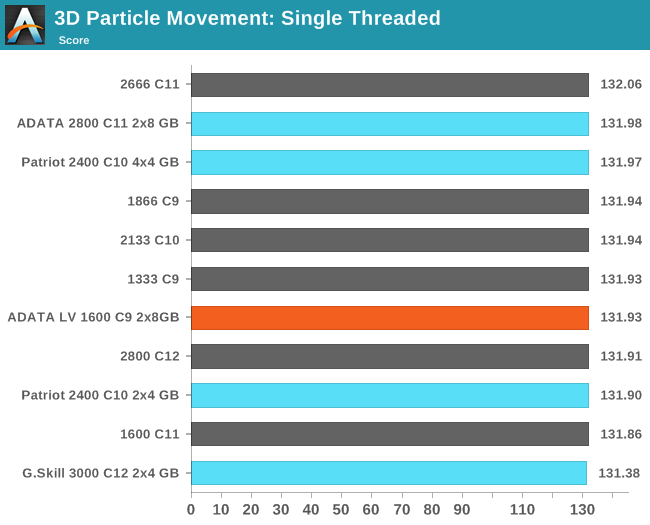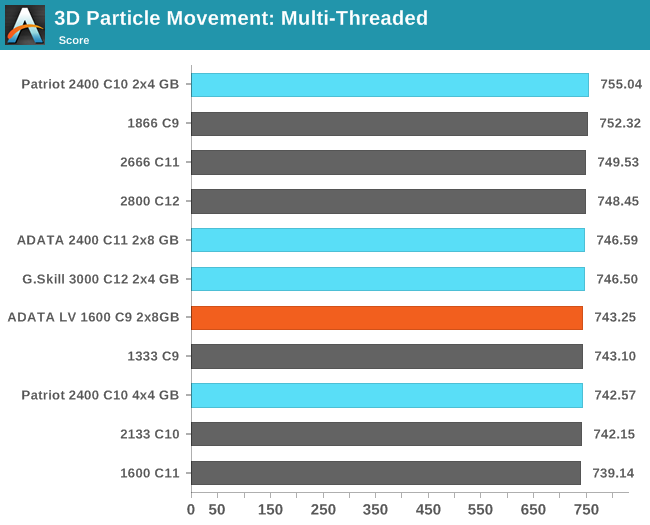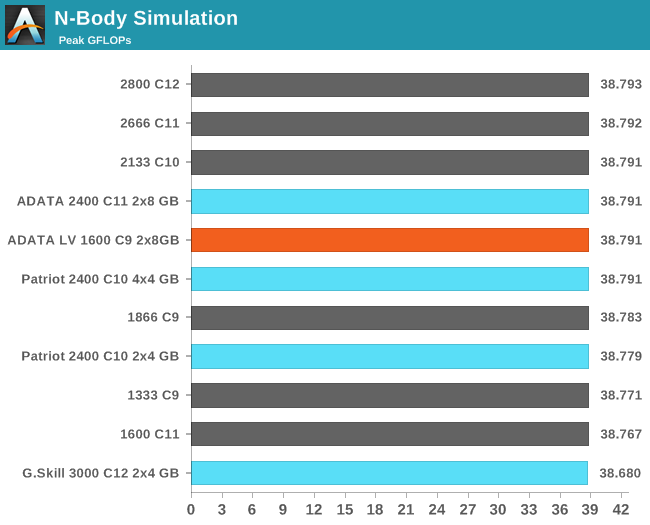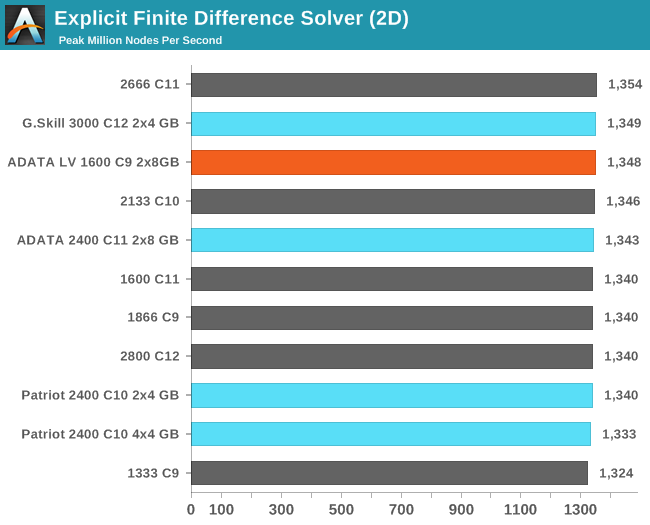ADATA XPG V1.0 Low Voltage Review: 2x8 GB at DDR3L-1600 9-11-9 1.35 V
by Ian Cutress on December 6, 2013 2:00 PM ESTCPU Compute
One side I like to exploit on CPUs is the ability to compute and whether a variety of mathematical loads can stress the system in a way that real-world usage might not. For these benchmarks we are ones developed for testing MP servers and workstation systems back in early 2013, such as grid solvers and Brownian motion code. Please head over to the first of such reviews where the mathematics and small snippets of code are available.
3D Movement Algorithm Test
The algorithms in 3DPM employ uniform random number generation or normal distribution random number generation, and vary in various amounts of trigonometric operations, conditional statements, generation and rejection, fused operations, etc. The benchmark runs through six algorithms for a specified number of particles and steps, and calculates the speed of each algorithm, then sums them all for a final score. This is an example of a real world situation that a computational scientist may find themselves in, rather than a pure synthetic benchmark. The benchmark is also parallel between particles simulated, and we test the single thread performance as well as the multi-threaded performance. Results are expressed in millions of particles moved per second, and a higher number is better.


N-Body Simulation
When a series of heavy mass elements are in space, they interact with each other through the force of gravity. Thus when a star cluster forms, the interaction of every large mass with every other large mass defines the speed at which these elements approach each other. When dealing with millions and billions of stars on such a large scale, the movement of each of these stars can be simulated through the physical theorems that describe the interactions. The benchmark detects whether the processor is SSE2 or SSE4 capable, and implements the relative code. We run a simulation of 10240 particles of equal mass - the output for this code is in terms of GFLOPs, and the result recorded was the peak GFLOPs value.

Grid Solvers - Explicit Finite Difference
For any grid of regular nodes, the simplest way to calculate the next time step is to use the values of those around it. This makes for easy mathematics and parallel simulation, as each node calculated is only dependent on the previous time step, not the nodes around it on the current calculated time step. By choosing a regular grid, we reduce the levels of memory access required for irregular grids. We test both 2D and 3D explicit finite difference simulations with 2n nodes in each dimension, using OpenMP as the threading operator in single precision. The grid is isotropic and the boundary conditions are sinks. We iterate through a series of grid sizes, and results are shown in terms of ‘million nodes per second’ where the peak value is given in the results – higher is better.


Grid Solvers - Implicit Finite Difference + Alternating Direction Implicit Method
The implicit method takes a different approach to the explicit method – instead of considering one unknown in the new time step to be calculated from known elements in the previous time step, we consider that an old point can influence several new points by way of simultaneous equations. This adds to the complexity of the simulation – the grid of nodes is solved as a series of rows and columns rather than points, reducing the parallel nature of the simulation by a dimension and drastically increasing the memory requirements of each thread. The upside, as noted above, is the less stringent stability rules related to time steps and grid spacing. For this we simulate a 2D grid of 2n nodes in each dimension, using OpenMP in single precision. Again our grid is isotropic with the boundaries acting as sinks. We iterate through a series of grid sizes, and results are shown in terms of ‘million nodes per second’ where the peak value is given in the results – higher is better.











35 Comments
View All Comments
Khenglish - Friday, December 6, 2013 - link
They do. It just costs more. Tons of 1600 9-9-9 T1 1.35V 8GB sticks on newegg. Even 1866 10-10-10 T1 8GB sticks.The question is if your laptop supports 1.35V or not. Only 8 series and a few 7 series laptops will run at 1.35V. Other laptops will run the memory at 1.5V despite it being 1.35V, which is fun if your laptop allows overclocking (which unfortunately is just top end clevo and alienware), but a waste of money and power if not.
jeffbui - Saturday, December 7, 2013 - link
Apple uses DDR3L in their Macbook Pros and LPDDR3 in their Air lineXpl1c1t - Friday, December 6, 2013 - link
Fail to see why this is something worth reviewing. Maybe in the 2009/2010 timeframe this would have been more relevant, but there were better performing kits available then @ 1.35v. Namely there were the GSkill ECO and Mushkin 996825 kits which were killer. I still run mine at 1700mhz 6-8-6-24-1T and 1.4v and am sure they could run well below 1.35v @ 1600.StrangerGuy - Saturday, December 7, 2013 - link
The more pressing question is the TOTAL lack of power consumption tests especially for standby states. C'mon who do you think the target customers are for low voltage RAM?MrSpadge - Sunday, December 8, 2013 - link
Those were probably 4 GB, or maybe even 2 GB modules.jeffrey - Saturday, December 7, 2013 - link
Ian Cutress,Hello! You keep writing articles about 1866/C9 being the minimum and to avoid 1600. Even going so far as to say, "Any kit 1600 MHz or less is usually bad news."
However, this ignores 1600/C8 modules. The 1600/C8 score a 200 on your Performance Index at stock timings. This is at your recommended 200 level. There are several kits of 2x4 GB 1600/C8 on Newegg that have memory profiles of 8-8-8-24 at 1.5v. I'll repeat, these 1600 8-8-8-24 1.5v kits score 200 on the Performance Index and hit the current memory sweet spot for most people of 2x4 GB. This scores within around 3% of the 1866/C9 kits which have a Performance score of 207.
The reason I bring this up is that the 1600 8-8-8-24 kits are often less expensive than the 1866/C9 kits and offer essentially all of the performance.
I enjoy reading your articles and appreciate the volume that you have contributed lately!
Hairs_ - Saturday, December 7, 2013 - link
if you look at the benchmarks for these articles, you'll see that the differences between any of the kits tested is either hairline marginal, within the boundaries of statistical error, or non existent with the exception of two tests: winrar 4.2 (and not earlier versions) and explicit solver. Since I doubt anyone is doing explicit solver on an Intel integrated graphics rig, and most people aren't using winrar, it's pretty clear that recommending anything other than a standard 1600 kit with decent timings is a waste of effort on Intel chips.However this appears to have slipped past anandtech's reviewers, so these meaningless articles continue.
GTVic - Saturday, December 7, 2013 - link
That didn't make any sense. The benchmark tool gives a performance index. Whether people use the software is irrelevant.Hairs_ - Sunday, December 8, 2013 - link
it's entirely relevant. It proves that with the exception of two very specific and rare use cases, these ram kits make no difference to much cheaper ones.ibemerson - Saturday, December 7, 2013 - link
The reason I have mostly seen given for using low voltage memory is that it will supposedly last longer, and enable CPU's with on-die memory controllers to last longer, especially since Intel specifies 1.5v for memory, while many kits run at 1.65v. Some of us want computers that keep working for 10+ years.One question I had when researching a possible X-79 build involves the fact that installing 8 sticks of RAM on a board will cause the on-die memory controller to auto-downclock the memory because of the increased load. Does low voltage ram avoid this?